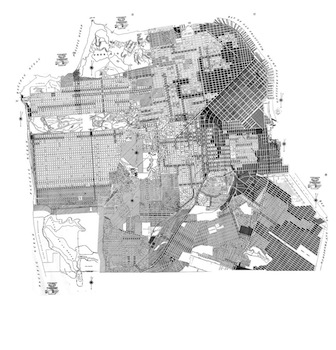Throughout the U.S., there are many communities afflicted by what I call “planners’ blight” and “zoning disease.” Northern California is especially impacted by these negative influences on private property land-use restrictions. Even before recent wildfires decimated the housing stock of the North Bay, there was already a long-term, intractable “housing crisis” since the early 1990s. There are different opinions why the North Bay went from being a relatively affordable place for people of modest means to live, to now being in crisis with residents overwhelmed by housing costs, and moving away. Unfortunately, “planners” are part of the problem, not the solution. Remember, “planning is politics” so both planners and politicians have shared in creating our housing crisis.
Planners’ blight are spots where you see a vacant lot, or a partially-demolished building with one wall still standing. If a property owner keeps one wall of a building, it’s considered a remodel rather than a new project. You can find examples of planners’ blight spots in Santa Rosa, near the Downtown SMART Rail Depot where projects proposed decades ago still languish. Another example is the Roseland Village Shopping Center, a place still struggling to get started building housing on a site where structures were demolished years ago. The vacant lots are blight, and they become a pox on a community. Some vacant lots can stay undeveloped for decades, while an owner waits to realize the economically “highest and best use” for the land. Sometimes, zoning restrictions keep a piece of land from ever being used.
Various planning agencies increase the difficulties for property owners to advance any type of housing projects on their land. A term used for these impediments is “zoning disease.” The phrase has been in use for decades. Land developers probably first used it as they found local government restrictions on land made it more difficult to develop projects. This started back in the early 1920s when the judicial system upheld zoning as a legitimate use of the “police powers” of a local government to help “maintain the health, safety and welfare” of a community. The focus here is on how now zoning has contributed to the housing crisis in Sonoma County and beyond during the last 30 years.
During the 1960s, the city of Santa Rosa began to “rezone” residential land projects near the downtown area to be used as “commercial.” Hundreds of housing units were taken out of residential use. The houses became sites for offices and small businesses. Historically, commercial land is seen as more valuable for the tax base of towns and cities, so loss of housing was not bemoaned at the time. Santa Rosa and most Sonoma County towns followed a “sprawl” pattern of growth with new houses being built farther and farther away from the town core for many years. Zoning actually kept more residential units from being built in closer to town centers because of large swaths of land there being zoned for commercial use.
Subdivisions of homes built on land away from town were more attractive to families. As a less common practice, some apartment buildings were built away from town centers in a category known as “multi-family” housing. Over time, the population of the North Bay swelled and there were more people than available housing units by the late 1980s. Housing became more attractive and useful, but because of zoning restrictions, residential land became harder to move through the various governmental agencies. Rather than working to expedite housing projects near town centers the process actually worked against building more “city centered” housing. Santa Rosa city documents from the 1993 Comprehensive Housing Affordability Strategy stated the situation was already worsening.
Now with the post-fire “Resiliency” ordinance Santa Rosa is using to advance more home building, local developers are back in the process, but not in the center of town where multi-family housing would be most beneficial. Financing for home construction is the crucial component and also more dependent on where zoning allows for housing to be built. Zoning could be used as an incentive with approaches such as “density bonuses” which allow more housing to be built in certain areas chosen by politicians. If Santa Rosa’s current interest in provision of housing can be harnessed to overcome zoning disease downtown and near the Railroad Square Depot, perhaps local planner’s blight might be vanquished. Cure zoning disease, and North Bay housing woes, as well as planner’s blight, could diminish. If not, the housing crisis could sadly last a lifetime.
Duane De Witt, MCP, is a founding member of the Sonoma County Housing Group, which was formed more than 20 years ago. The group is focused on community development and housing. He can be contacted at dewittplanner@yahoo.com.




